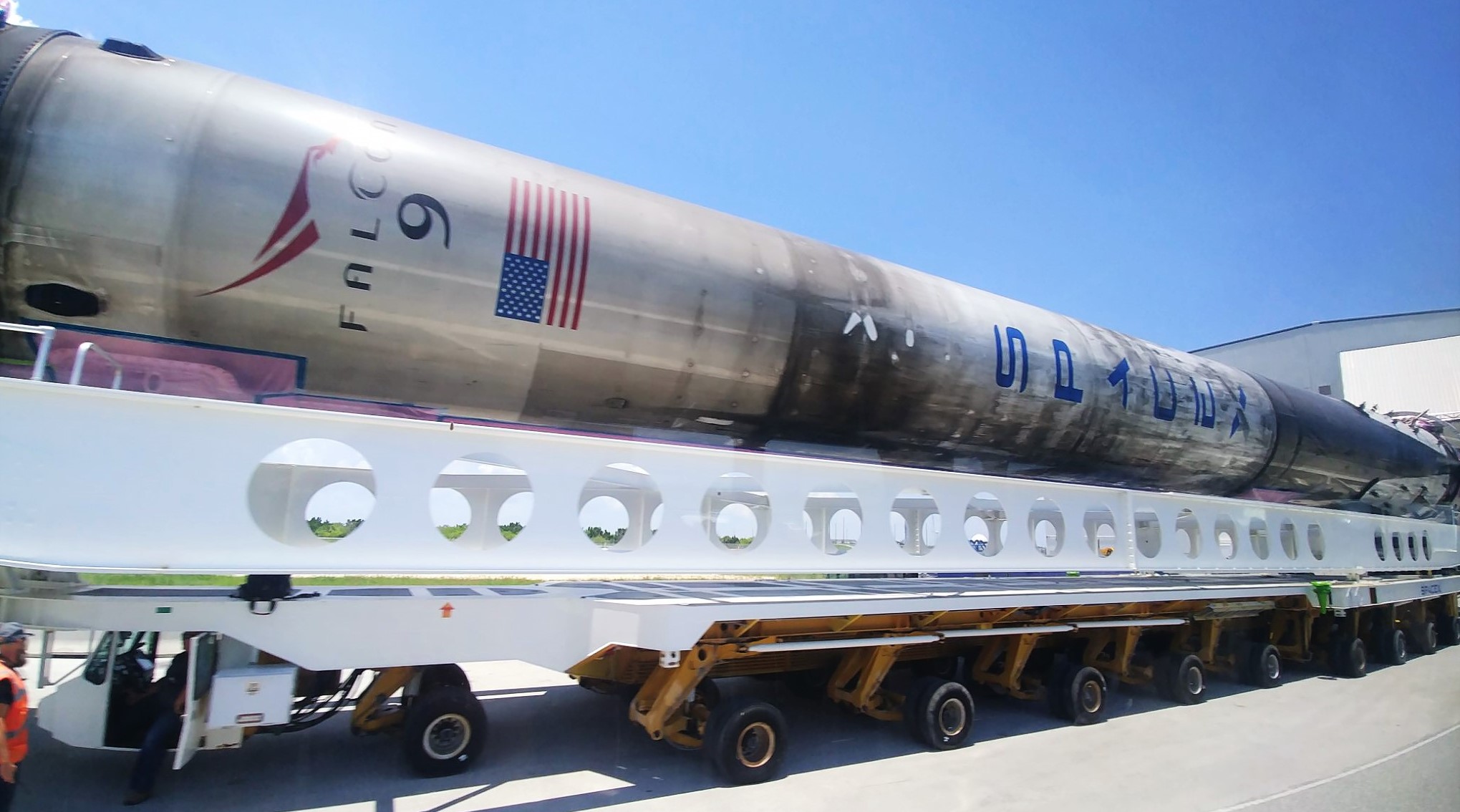
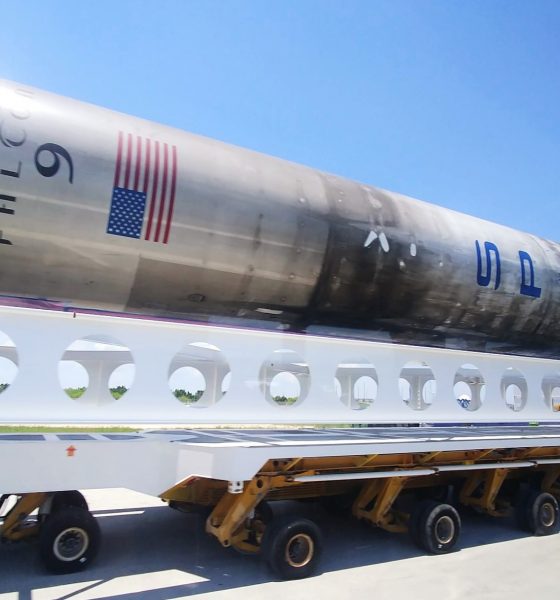
News
SpaceX fan spots sooty Falcon 9 Block 5 booster at Kennedy Space Center
On July 2nd, Twitter user Sideralmente (@astroperinaldo) spotted a sooty Falcon 9 Block 5 booster arriving at SpaceX’s Pad 39A hangar facilities, currently operating as a sort of defacto refurbishment hub.
Likely a prelude to a near-term launch, SpaceX has several missions scheduled over the next few months. More likely than not, all of them will fly on flight-proven Falcon 9 boosters, now so common that launching new boosters has started to feel exceedingly rare and unusual. July 2nd’s booster spotting is also a rare (albeit slightly less rare) treat, given the general lack of access (aside from a bus tour) members of the public have to Kennedy Space Center’s operational facilities and the total lack of access they have to Cape Canaveral Air Force Station, home of SpaceX’s most active launch pad (LC-40).
CRS-18
Up next for SpaceX is Cargo Dragon CRS-18, the spacecraft’s second International Space Station (ISS) resupply mission this year. At least over the last 2-3 years, SpaceX and NASA have been fairly consistent with Cargo Dragon launches in the winter, late-spring/early-summer, and late-fall (Q1, Q2/Q3, Q4) for an average of three launches annually. 2018/2019 is no different: CRS-16 launched in early-December 2018 and CRS-17 in early-May 2019, while CRS-18 is scheduled to launch NET 7:35 pm ET, July 21st and CRS-19 is targeted for early-December 2019.

Meanwhile, CRS-18 is also expected to be the first time a NASA mission launches on a flight-proven Falcon 9 Block 5 booster, potentially paving the way for NASA’s first launch on a twice-flown Block 5 booster with CRS-19 – hopefully later this year. Of course, that subsequent milestone will depend on a successful launch and landing during CRS-18. Falcon 9 booster B1056 – previously tasked with launching CRS-17 on May 4th, 2019 – is assigned to the mission and has been speedily refurbished for its next mission. Assuming the static fire goes well and there are no anomalies over the next 11 days, B1056 will launch twice in 78 days, a close second to B1048, B1052, and B1053 – all tied for first place at 74 days.
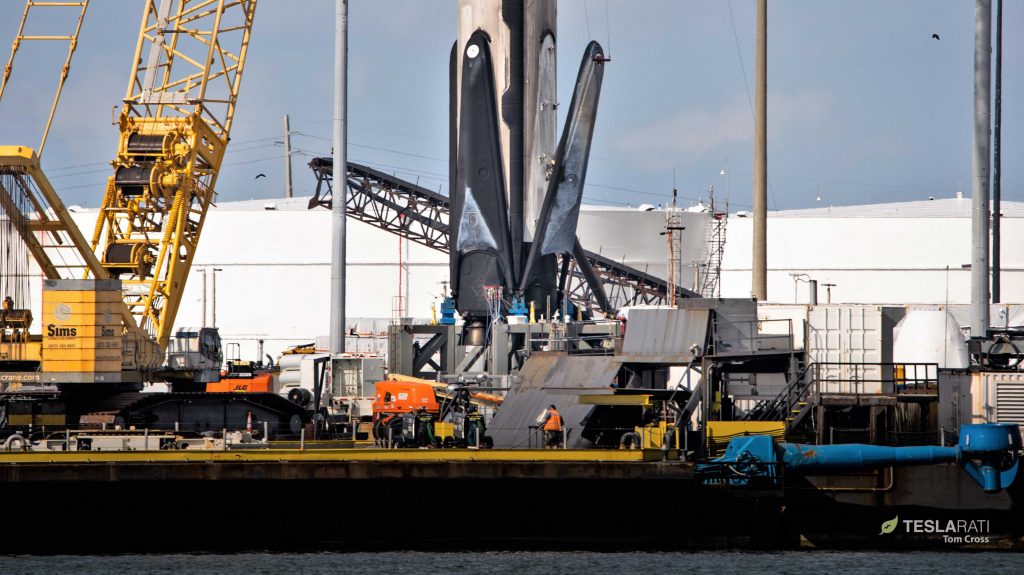
AMOS-17
Following CRS-18, SpaceX’s next launch is expected to occur soon after, launching Spacecom’s AMOS-17 communications satellite on a Falcon 9 (likely flight-proven) no earlier than early-August, although the tail-end of July is also a possibility. This mission will be extremely symbolic, owing to the fact that AMOS-17 is effectively an insurance-funded replacement for AMOS-6, destroyed on September 1st, 2016 when Falcon 9 suffered a catastrophic failure.
Thankfully, since that failure nearly three years ago, Falcon 9 has performed admirably, suffering no publicly-known failures or partial failures during its primary mission, although SpaceX has suffered two failed booster landing attempts over the same period.
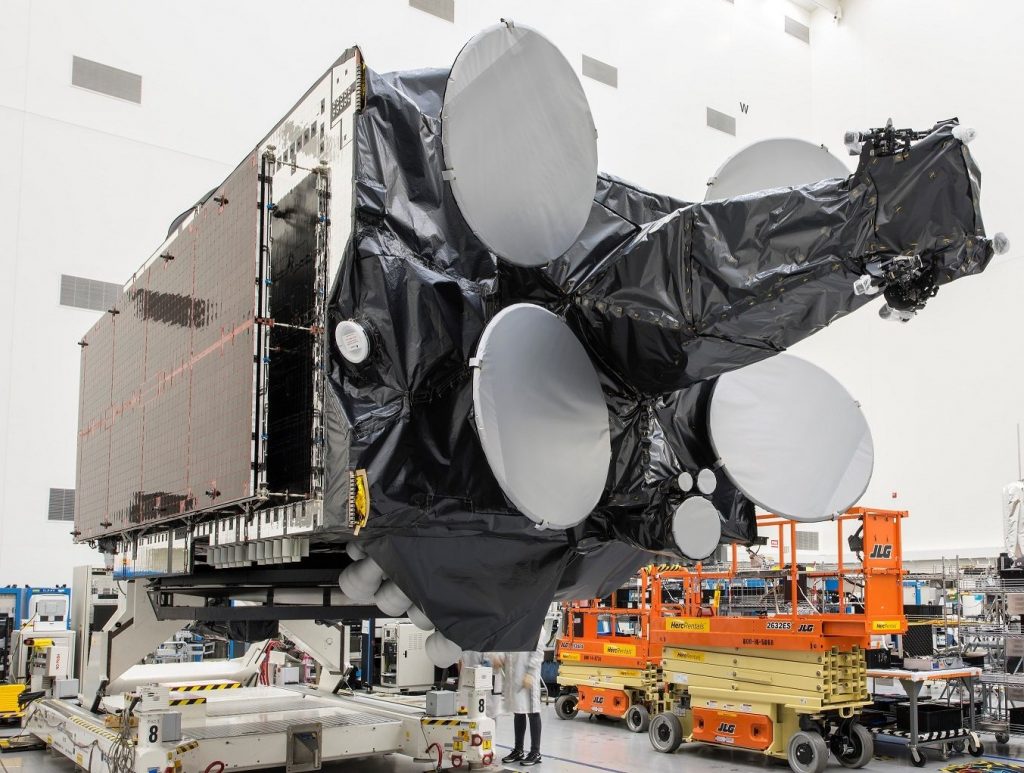
It’s possible that the mystery booster spotted above is meant for AMOS-17, although that’s far from certain. Based on an image showing the core number, it is almost certainly B104X, while the second digit could easily be a 7 or a 9. If the booster in question is B1047, the odds are much better that it’s wrapping up refurbishment and waiting at 39A for CRS-18 to launch before heading to LC-40.
Starlink?
On the other hand, if the booster in question is B1049, it can be all but guaranteed that AMOS-17 will not launch on it, the reason being that – quite literally burned by its last experience with Falcon 9 – Spacecom probably doesn’t want to be the first SpaceX customer to launch on a thrice-flown booster. At the same time, SpaceX is probably exceptionally conscious of the need to ensure mission success and has no interest in adding risk to the AMOS-17 mission profile, no matter how minor.
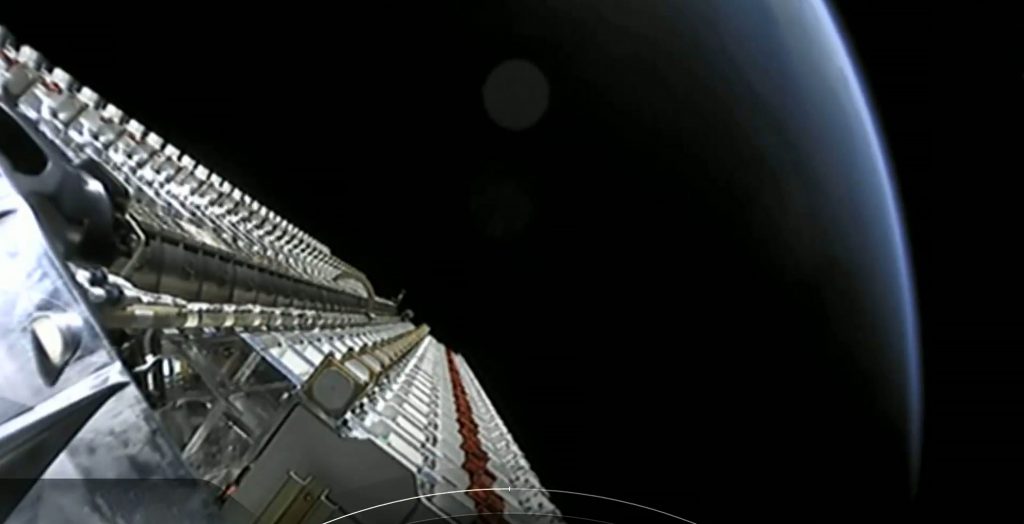
B1049 launched for the third time in support of SpaceX’s first dedicated Starlink launch on May 23rd, known internally as Starlink v0.9. At this point in time, B1046.3 is believed to be assigned to Crew Dragon’s in-flight abort (IFA) test, expected no earlier than Q4 2019. B1048.3’s status is unknown since the rocket successfully completed its third launch in February 2019. With B1049’s newfound history as the first SpaceX booster to launch on a completely internal mission, it would make a lot of sense for SpaceX to reuse B1049 for the next Starlink mission.
Simultaneously, SpaceX could demonstrate the first launch of a thrice-flown Falcon 9 booster without pushing that risk onto customers, opening up B1048 and future thrice-flown boosters for near-term commercial missions. A step further, this would set SpaceX up perfectly to use internal Starlink missions as full-fidelity demonstrations of booster reuse milestones, going from the four launches to five, six, seven, and beyond.
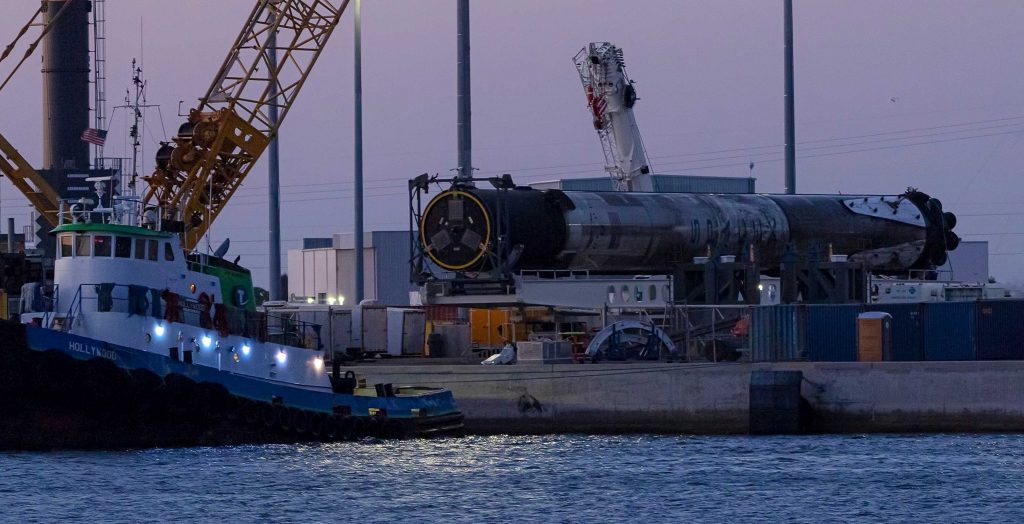
Check out Teslarati’s Marketplace! We offer Tesla accessories, including for the Tesla Cybertruck and Tesla Model 3.

News
Tesla China quietly posts Robotaxi-related job listing
Tesla China is currently seeking a Low Voltage Electrical Engineer to work on circuit board design for the company’s autonomous vehicles.

Tesla has posted a new job listing in Shanghai explicitly tied to its Robotaxi program, fueling speculation that the company is preparing to launch its dedicated autonomous ride-hailing service in China.
As noted in the listing, Tesla China is currently seeking a Low Voltage Electrical Engineer to work on circuit board design for the company’s autonomous vehicles.
Robotaxi-specific role
The listing, which was shared on social media platform X by industry watcher @tslaming, suggested that Tesla China is looking to fill the role urgently. The job listing itself specifically mentions that the person hired for the role will be working on the Low Voltage Hardware team, which would design the circuit boards that would serve as the nervous system of the Robotaxi.
Key tasks for the role, as indicated in the job listing, include collaboration with PCB layout, firmware, mechanical, program management, and validation teams, among other responsibilities. The role is based in Shanghai.
China Robotaxi launch
China represents a massive potential market for robotaxis, with its dense urban centers and supportive policies in select cities. Tesla has limited permission to roll out FSD in the country, though despite this, its vehicles have been hailed as among the best in the market when it comes to autonomous features. So far, at least, it appears that China supports Tesla’s FSD and Robotaxi rollout.
This was hinted at in November, when Tesla brought the Cybercab to the 8th China International Import Expo (CIIE) in Shanghai, marking the first time that the autonomous two-seater was brought to the Asia-Pacific region. The vehicle, despite not having a release date in China, received a significant amount of interest among the event’s attendees.
Elon Musk
Elon Musk and Tesla AI Director share insights after empty driver seat Robotaxi rides
The executives’ unoccupied tests hint at the rapid progress of Tesla’s unsupervised Robotaxi efforts.

Tesla CEO Elon Musk and AI Director Ashok Elluswamy celebrated Christmas Eve by sharing personal experiences with Robotaxi vehicles that had no safety monitor or occupant in the driver’s seat. Musk described the system’s “perfect driving” around Austin, while Elluswamy posted video from the back seat, calling it “an amazing experience.”
The executives’ unoccupied tests hint at the rapid progress of Tesla’s unsupervised Robotaxi efforts.
Elon and Ashok’s firsthand Robotaxi insights
Prior to Musk and the Tesla AI Director’s posts, sightings of unmanned Teslas navigating public roads were widely shared on social media. One such vehicle was spotted in Austin, Texas, which Elon Musk acknowleged by stating that “Testing is underway with no occupants in the car.”
Based on his Christmas Eve post, Musk seemed to have tested an unmanned Tesla himself. “A Tesla with no safety monitor in the car and me sitting in the passenger seat took me all around Austin on Sunday with perfect driving,” Musk wrote in his post.
Elluswamy responded with a 2-minute video showing himself in the rear of an unmanned Tesla. The video featured the vehicle’s empty front seats, as well as its smooth handling through real-world traffic. He captioned his video with the words, “It’s an amazing experience!”
Towards Unsupervised operations
During an xAI Hackathon earlier this month, Elon Musk mentioned that Tesla owed be removing Safety Monitors from its Robotaxis in Austin in just three weeks. “Unsupervised is pretty much solved at this point. So there will be Tesla Robotaxis operating in Austin with no one in them. Not even anyone in the passenger seat in about three weeks,” he said. Musk echoed similar estimates at the 2025 Annual Shareholder Meeting and the Q3 2025 earnings call.
Considering the insights that were posted Musk and Elluswamy, it does appear that Tesla is working hard towards operating its Robotaxis with no safety monitors. This is quite impressive considering that the service was launched just earlier this year.
Elon Musk
Starlink passes 9 million active customers just weeks after hitting 8 million
The milestone highlights the accelerating growth of Starlink, which has now been adding over 20,000 new users per day.

SpaceX’s Starlink satellite internet service has continued its rapid global expansion, surpassing 9 million active customers just weeks after crossing the 8 million mark.
The milestone highlights the accelerating growth of Starlink, which has now been adding over 20,000 new users per day.
9 million customers
In a post on X, SpaceX stated that Starlink now serves over 9 million active users across 155 countries, territories, and markets. The company reached 8 million customers in early November, meaning it added roughly 1 million subscribers in under seven weeks, or about 21,275 new users on average per day.
“Starlink is connecting more than 9M active customers with high-speed internet across 155 countries, territories, and many other markets,” Starlink wrote in a post on its official X account. SpaceX President Gwynne Shotwell also celebrated the milestone on X. “A huge thank you to all of our customers and congrats to the Starlink team for such an incredible product,” she wrote.
That growth rate reflects both rising demand for broadband in underserved regions and Starlink’s expanding satellite constellation, which now includes more than 9,000 low-Earth-orbit satellites designed to deliver high-speed, low-latency internet worldwide.
Starlink’s momentum
Starlink’s momentum has been building up. SpaceX reported 4.6 million Starlink customers in December 2024, followed by 7 million by August 2025, and 8 million customers in November. Independent data also suggests Starlink usage is rising sharply, with Cloudflare reporting that global web traffic from Starlink users more than doubled in 2025, as noted in an Insider report.
Starlink’s momentum is increasingly tied to SpaceX’s broader financial outlook. Elon Musk has said the satellite network is “by far” the company’s largest revenue driver, and reports suggest SpaceX may be positioning itself for an initial public offering as soon as next year, with valuations estimated as high as $1.5 trillion. Musk has also suggested in the past that Starlink could have its own IPO in the future.








